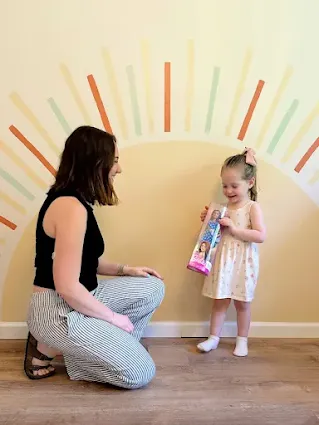Mattel Launches First-Ever Type 1 Diabetes Barbie to Represent Hundreds of Thousands of Children in the U.S.
 |
The new Barbie comes with an insulin pump, a glucose monitor and snacks to help her control her blood sugar. ( |
The launch of this groundbreaking doll comes during the Breakthrough T1D Children’s Congress, a three-day advocacy event in Washington, D.C., where kids and teens living with the autoimmune disease meet lawmakers and urge continued federal funding for diabetes research and care.
💉 Barbie Wears an Insulin Pump and Glucose Monitor
Dressed in a trendy blue polka-dot crop top, ruffled mini skirt, chunky heels, and carrying a matching light-blue purse, this Barbie also features two key medical accessories:
-
An insulin pump attached to her waist
-
A continuous glucose monitor (CGM) on her upper arm, secured with heart-shaped Barbie-pink tape
The doll’s smartphone displays a real-time glucose monitoring app, with her reading showing 130 mg/dL, a healthy level within the normal range of 70 to 180 mg/dL.
"This Barbie isn’t just a toy — she’s a message of inclusion, awareness, and representation for kids with Type 1 diabetes,” said Emily Mazreku, Director of Marketing and Communications at Breakthrough T1D.
Courtesy Mattel)
🏛️ Why This Doll Matters Now
The debut of the doll arrives at a critical moment. Advocacy efforts at the Children’s Congress are focused on urging lawmakers to renew the Special Diabetes Program, a federal initiative first passed in 1997 that funds diabetes research, treatment, and support.
The program’s current funding expires after September 2025, and organizations like Breakthrough T1D are calling for renewed commitment in light of federal budget cuts that have jeopardized health-related programs.
“This doll helps bring visibility to a disease that affects so many children,” said Mazreku. “We hope it inspires action.”
🧠 What Is Type 1 Diabetes?
Type 1 diabetes is an autoimmune disease in which the immune system attacks insulin-producing cells in the pancreas. Unlike Type 2 diabetes, which often develops due to insulin resistance, people with Type 1 produce little to no insulin on their own and must rely on daily injections or an insulin pump to survive.
It can be diagnosed at any age, but most cases are identified in childhood or adolescence. If not properly managed, blood sugar levels can swing dangerously high or low, which is why devices like CGMs are crucial for day-to-day care.
👧 Representation in the Barbie Line
This new doll is part of Barbie’s Fashionista line, which now features more than 175 different dolls with varying skin tones, body types, hair textures, and disabilities. Other inclusive dolls in the collection include:
-
A Barbie with vitiligo
-
A Barbie with Down syndrome
-
A blind doll with a white cane
-
A Barbie with a prosthetic leg
-
A doll with behind-the-ear hearing aids
“Our goal is to reflect the world kids see around them,” said Devin Duff, a Mattel spokesperson. “The popularity of our inclusive dolls shows that representation truly matters.”
🌎 The Power of Inclusive Play
Experts like Dr. Sian Jones, co-founder of the Toy Box Diversity Lab at Queen Margaret University in Edinburgh, support the growing push for inclusive toys. Jones, who lives with cerebral palsy, says toys with disabilities act as both “mirrors and windows” — reflecting a child’s own identity while offering insight into others’ experiences.
“When kids play with dolls that use wheelchairs or insulin pumps, they develop empathy and awareness of real-life accessibility challenges,” she said. “It leads to more compassionate future generations.”
💖 A Personal Milestone for Families
For Emily Mazreku, who helped design the doll and lives with Type 1 diabetes herself, the moment was deeply personal.
“When I brought the Barbie home, my 3-year-old daughter said, ‘She looks like Mommy,’” Mazreku shared, holding back tears. “Even though my daughter doesn’t have diabetes, she sees me living with it daily — and now she sees Barbie doing the same.”
 |
Emily Mazreku says it's "really special" for her own daughter to play with the doll. ( |
🏠 From Dream Houses to Real Impact
Mattel’s first attempt at disability inclusion came in 1997 with Share-a-Smile Becky, a friend for Barbie who used a wheelchair. However, at the time, the wheelchair couldn’t fit through Barbie’s Dream House doors — an example of the real-world challenges many people with disabilities still face.
Today, Mattel has evolved. It continues to design dolls that not only fit diverse realities but also advocate for broader systemic change in how disability is understood and accepted.
🔍 The Big Picture
-
Type 1 diabetes affects over 1.9 million Americans, including children and adults.
-
Representation in toys helps destigmatize medical conditions and empower children.
-
Inclusive dolls like this one spark important conversations in families, schools, and communities.
-
Advocates hope this doll brings attention to funding gaps, encourages research support, and nurtures self-confidence in children with diabetes.

Comments
Post a Comment